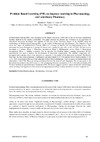Please use this identifier to cite or link to this item:
https://accedacris.ulpgc.es/handle/10553/58104
| Title: | Problem Based Learning (PBL) to improve learning in Pharmacology and veterinary Pharmacy | Authors: | Bordón, Elisa Núñez-González, Eduardo Loro-Ferrer, Juan Francisco |
UNESCO Clasification: | 58 Pedagogía 530602 Innovación tecnológica 3109 Ciencias veterinarias |
Keywords: | Problem Based Learning Pharmacology Veterinary EVIA |
Issue Date: | 2019 | Conference: | VI Jornadas Iberoamericanas de Innovación Educativa en el Ámbito de las TIC y las TAC (InnoEducaTIC 2019) | Abstract: | Problem-based learning (PBL) was introduced at Mc-Master University (1968) and is one of the most consolidated learning methods in the medical curriculum. This paper presents the process and evaluation of an experience of educational innovation developed with students of 2nd year of the Veterinary Degree of the ULPGC using the methodology of Problem based learning (PBL) in the subject of Pharmacology and pharmacy. The Objective was to assess the impact of problem-based learning (PBL) as a strategy to improve the teaching-learning process. The innovation has been developed in 15 groups of clinical cases, during the dates 16/4 to 16/5 of 2019. The process was developed in 4 phases: Phase 1. Theoretical introduction, Phase 2. Bibliographic review, Phase 3. Intervention development, Phase 4. Opinion evaluation. For its analysis, the Problem Impact Learning Assessment (EVIA) questionnaire was used to analyze the development of transversal competencies. The students' competency selfperception and academic results were analyzed as a measure of the quality of the innovation developed. The Results show that the best valued dimension is satisfaction and achievement (4.13; 1.05) and the lowest Transversability (3.18; 1.27). There is not much difference in the valuations of the different dimensions. There is a great correlation between the dimensions of the EVIA. There are strong correlations between the items of each dimension. The average grade of the theoretical exam taken in the 2019 course (n = 60) eliminating those not presented is (7.45; 1.12) with a minimum of 0 for those students not presented and a maximum of 9.6. The results suggest a positive impact of this new methodology on the teaching-learning process of the students by improving their self-perception of domain over their competencies. | URI: | https://accedacris.ulpgc.es/handle/10553/58104 | ISBN: | 978-84-09-14325-2 | Source: | VI Jornadas Iberoamericanas de Innovación Educativa en el Ámbito de las TIC y las TAC, Las Palmas de Gran Canaria, 14 y 15 de noviembre de 2019, p. 383-390 |
| Appears in Collections: | Actas de congresos |
Page view(s)
197
checked on Mar 1, 2025
Download(s)
270
checked on Mar 1, 2025
Google ScholarTM
Check
Altmetric
Share
Export metadata
Items in accedaCRIS are protected by copyright, with all rights reserved, unless otherwise indicated.
